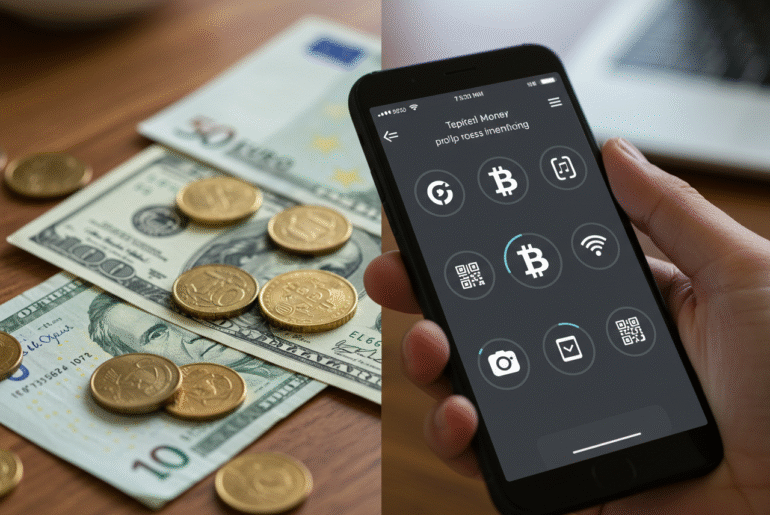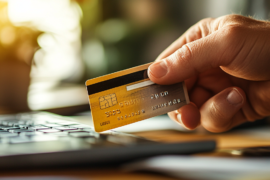This article may contain references to products or services from one or more of our advertisers or partners. We may receive compensation when you click on links to those products or services. Nonetheless, our opinions are our own.
The information presented in this article is accurate to the best of our knowledge at the time of publication. However, information is subject to change, and no guarantees are made about the continued accuracy or completeness of this content after its publication date.
- Introduction
- Electronic Money vs. Traditional Currency: What’s Different
- Historical Evolution Of Money
- Milestones In The Rise Of E-Money
- How Electronic Money Works
- Digital Wallets And Prepaid Accounts
- Linking E-Money To Bank Accounts
- Comparing Features: Electronic Money vs. Traditional Currency
- Summary Highlights
- Frequently Asked Questions
- Is electronic money legal tender in the United States?
- Are digital wallets and cryptocurrencies considered legal money?
- How is electronic money protected against fraud?
- Can electronic money be converted to cash?
- Are there fees associated with electronic money?
- What risks come with electronic money compared to cash?
- Final Thoughts
- Recommended Reads
Introduction
Electronic money differs from traditional currency in its form and use. While conventional currency consists of physical coins and paper bills, electronic money exists solely in digital form, accessible via phones or computers. This digital form enables payments and transfers with speed and convenience that are not possible with cash. Both serve as methods of payment, but electronic money operates through digital systems, contrasting with the tangible nature of traditional currency.
Electronic Money vs. Traditional Currency: What’s Different
Defining Electronic Money And Traditional Currency
Electronic money exists digitally, stored and transferred using devices like computers and phones. Traditional currency, also known as fiat money, is issued by governments and comprises physical coins and paper notes. Both types allow value exchange, but electronic money provides faster, easier transfers and advanced security methods, whereas traditional currency relies on physical exchange.
What Is Electronic Money?
The electronic money revolution is transforming payment processes through digital wallets, bank accounts, and prepaid cards. It supports fast transactions without needing physical bank visits. Central banks and institutions back e-money, ensuring security and trust. Payment providers and electronic money institutions facilitate global transfers, making e-money widely accessible.
What Is Traditional Currency?
Traditional currency gains value through government backing and is widely used in daily commerce. It offers a tangible exchange, allowing deposits and withdrawals at banks or ATMs. However, transferring large sums internationally with cash can be slow and cumbersome. Despite its limitations, cash remains trusted due to its regulatory stability and role as a store of value.
Historical Evolution Of Money
From Barter To Digital Currencies
Initially, goods were exchanged directly through barter. The introduction of metal coins marked a shift toward representative money. Fiat currency emerged later, supported by banks, which increased financial power. The rise of electronic money introduced quicker, more accessible payment methods, expanding participation in the economic system.
The Transformation From Physical To Digital
The transition from paper currency to digital money reflects economic and technological changes. Online banking and electronic funds transfers eliminate the need for physical bank visits. E-money enables immediate payments, such as direct deposits and mobile payments, thereby increasing convenience and offering users more options.
Milestones In The Rise Of E-Money
- Early use of e-money focused on online transfers
- Mobile phones made digital money more accessible
- Apps like Venmo simplified instant peer-to-peer payments
- Cryptocurrencies introduced decentralized money management
- Prepaid cards provide purpose-specific digital funds
- Regulatory frameworks from central banks improved safety and trust
Voted "Best Overall Budgeting App" by Forbes and WSJ
Monarch Money helps you budget, track spending, set goals, and plan your financial future—all in one app.
Get 50% OFF your first year with code MONARCHVIP
How Electronic Money Works
Electronic money operates via various payment systems and digital platforms. Payment service providers and digital wallets facilitate secure and quick transactions. Automated clearinghouses facilitate the movement of funds, while strong customer verification minimizes the risk of fraud. These mechanisms ensure digital payments are as reliable and safe as cash.
Digital Wallets And Prepaid Accounts
Prepaid accounts allow users to load funds in advance for spending or payments. Benefits include:
- Instant balance updates and transaction alerts
- Easy fund management and top-ups
- User-friendly interfaces for efficient transactions
Digital wallets extend these features by supporting bill payments and budgeting tools, enhancing financial management.
Linking E-Money To Bank Accounts
Bank accounts enable electronic money transfers such as direct deposits and instant payments via services like Zelle. These systems connect banks worldwide, facilitating smooth, secure cross-border transactions. Continuous technological improvements strengthen these infrastructures, ensuring reliable global money movement.
Comparing Features: Electronic Money vs. Traditional Currency
Accessibility And Convenience
Electronic money provides faster and more convenient access through digital wallets and mobile devices, outperforming cash and checks in terms of speed and ease.
Security And Fraud Protection
Digital payments utilize encryption and strong customer authentication, thereby reducing the risk of fraud. Unlike physical cash, digital transactions are traceable, which aids in fraud detection. Regulatory oversight ensures safe usage and helps combat illegal activities.
Summary Highlights
- Electronic money operates digitally; traditional currency is physical
- E-money enables fast, secure online and mobile payments
- Cash provides tangibility and broad acceptance, but has transfer limits
- Digital wallets and prepaid accounts offer enhanced money management
- Global banking networks support instant electronic transfers
- Strong security measures protect digital payments from fraud
Frequently Asked Questions
Is electronic money legal tender in the United States?
No. Only government-issued coins and paper bills qualify as legal tender. Electronic money is widely used but not legally required for debt payment.
Are digital wallets and cryptocurrencies considered legal money?
No. Legal tender status is limited to physical currency issued by the government.
How is electronic money protected against fraud?
Protection includes encryption, two-factor authentication, transaction monitoring, and fraud response services.
Can electronic money be converted to cash?
Yes. Most digital wallets allow transfers to bank accounts or ATM withdrawals, often with possible fees.
Are there fees associated with electronic money?
Yes. Fees vary by provider and service type, including transaction and withdrawal fees.
What risks come with electronic money compared to cash?
Risks include hacking, data theft, technical failures, hidden fees, and potential loss if providers fail to meet their obligations. Cash remains straightforward but less versatile.
Final Thoughts
The use of money is evolving from physical to digital forms. Electronic money provides speed, convenience, and security, complementing traditional cash. Understanding their differences supports informed financial decisions. Both types remain essential in today’s economy, offering varied advantages for managing payments and value.

Reviewed and edited by Albert Fang.
See a typo or want to suggest an edit/revision to the content? Use the contact us form to provide feedback.
At FangWallet, we value editorial integrity and open collaboration in curating quality content for readers to enjoy. Much appreciated for the assist.
Did you like our article and find it insightful? We encourage sharing the article link with family and friends to benefit as well - better yet, sharing on social media. Thank you for the support! 🍉
Article Title: Electronic Money vs. Traditional Currency: What’s Different?
https://fangwallet.com/2025/06/09/electronic-money-vs-traditional-currency/The FangWallet Promise
FangWallet is an editorially independent resource - founded on breaking down challenging financial concepts for anyone to understand since 2014. While we adhere to editorial integrity, note that this post may contain references to products from our partners.
The FangWallet promise is always to have your best interest in mind and be transparent and honest about the financial picture.
Become an Insider

Subscribe to get a free daily budget planner printable to help get your money on track!
Make passive money the right way. No spam.
Editorial Disclaimer: The editorial content on this page is not provided by any of the companies mentioned. The opinions expressed here are the author's alone.
The content of this website is for informational purposes only and does not represent investment advice, or an offer or solicitation to buy or sell any security, investment, or product. Investors are encouraged to do their own due diligence, and, if necessary, consult professional advising before making any investment decisions. Investing involves a high degree of risk, and financial losses may occur including the potential loss of principal.
Source Citation References:
+ Inspo
There are no additional citations or references to note for this article at this time.












































